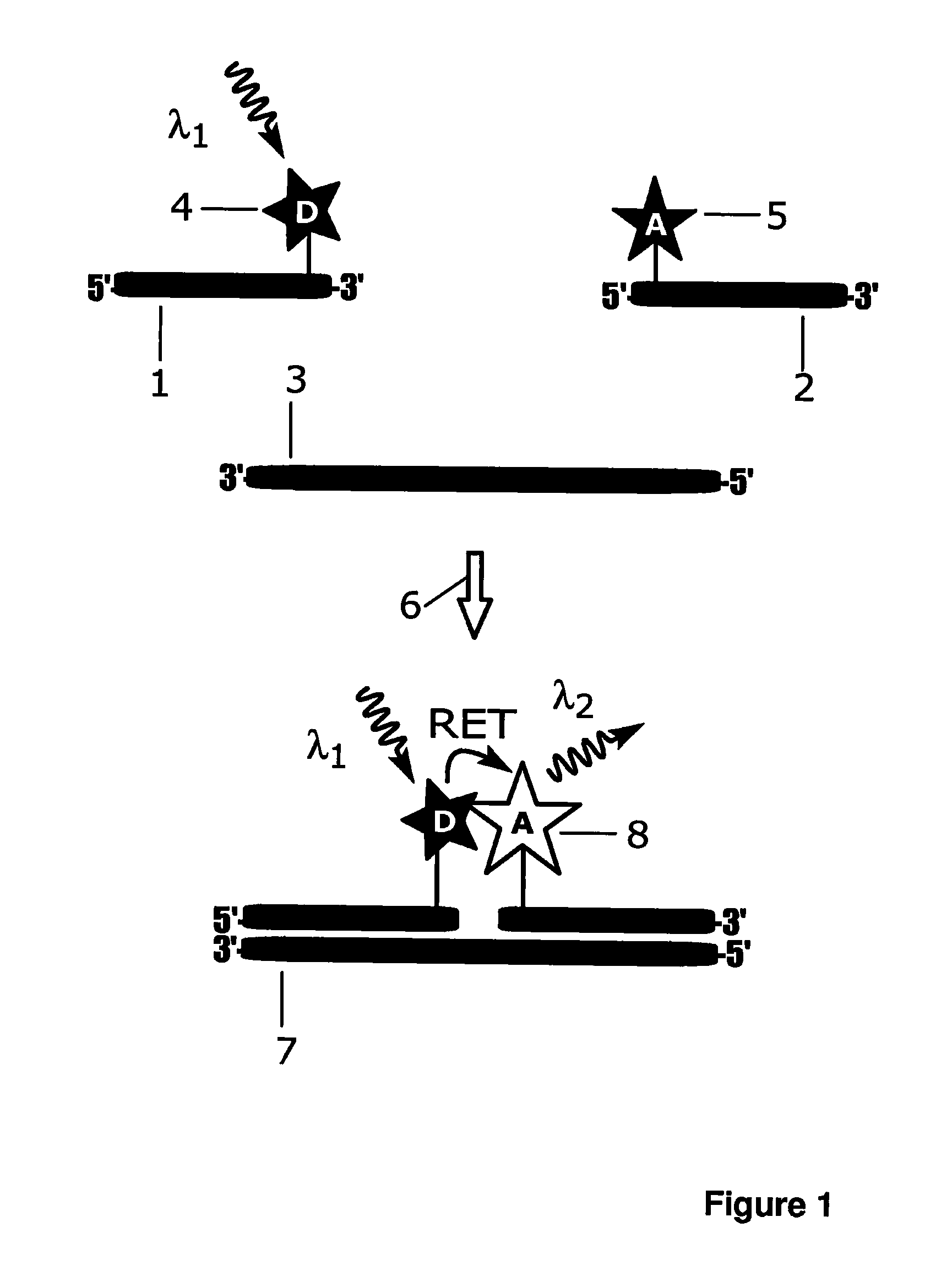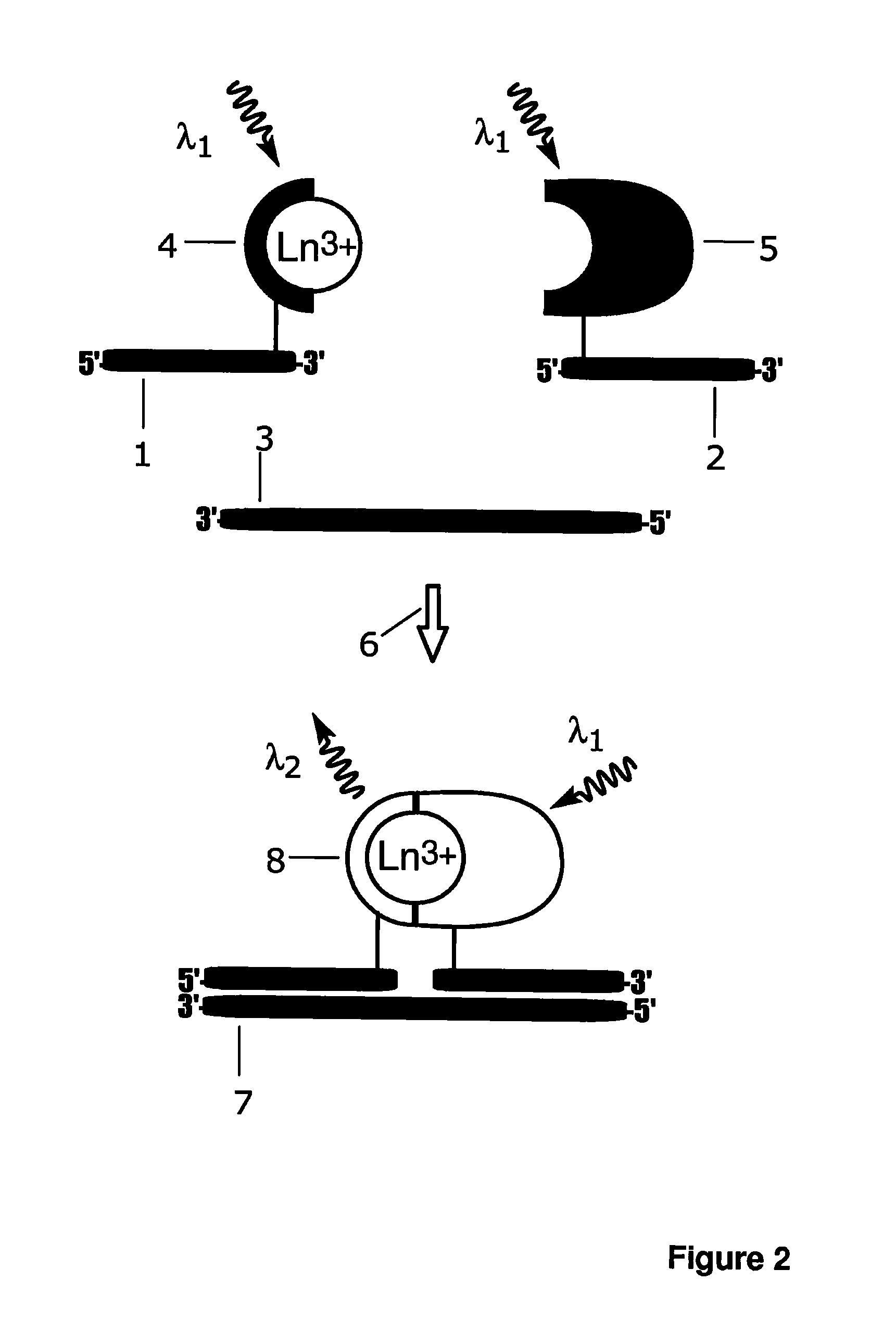Luminescence assay method
a technology of luminescence and assay method, which is applied in the field of bioassay method, can solve the problems of inability to easily construct or miniaturize instruments, inability to detect sensitively, and inability to universally employ, and achieve the effect of reducing fluorescen
- Summary
- Abstract
- Description
- Claims
- Application Information
AI Technical Summary
Benefits of technology
Problems solved by technology
Method used
Image
Examples
example 1
Homogeneous Proximity Probe-based Hybridization Assay
[0160]Synthetic target DNA oligonucleotide (5′-GATGCAGTAGCAGGAAGAGGATCG-TAGCAATG-3′; SEQ ID NO: 1), amino-modified probe A oligonucleotide (5′-CAT-TGCTACGATCC(C6dT)C-3′; SEQ ID NO: 2) and amino-modified probe B oligonucleotide (5′-T(C2dT)CCTGCTACTGCATC-3′; SEQ ID NO: 3) were purchased from Sigma-Aldrich (St. Louis, Mo.). Probe A was labelled with Eu3+ ion carrier chelate, (N1-(4-isothiocyanatobenzyl)diethylenetriamine-N1,N2,N3,N3-tetrakis(acetato)europium(III) [Mukkala, V.-M. et al.(1989) Anal. Biochem., 176: 319], Eu3+-N1) at the primary amino group modification located near the 3′-end and probe B was labelled with light harvesting antenna ligand (4-((isothio-cyanatophenyl)ethynyl)pyridine-2,6-dicarboxylic acid, 3d-antenna) near the 5′-end. Probe A, 25 nmol, was incubated with 20-fold molar excess of Eu3+-N1 in 50 mM carbonate buffer, pH 9.8, at +37° C. over night. The total volume of the labelling reactions was 50 μL. For labell...
example 2
Specificity in Signal Generation
[0166]Non-complementary target oligonucleotide (5′- CTGCTCTATCCACGGCG-CCCGCGGCTCCTCTC-3′; SEQ ID NO: 4) was purchased from Biomers.net (Ulm, Germany). The experiment described in Example 1 was repeated by replacing the target oligonucleotide with the non-complementary target oligonucleotide. Replacement of the complementary target oligonucleotide with variable concentrations of a noncomplementary 32-mer oligonucleotide resulted in the same fluorescence signal as in the absence of complementary target oligonucleotide; no detectable signal differences were observed in presence of variable concentrations non-complementary target oligonucleotides compared to zero concentration of target oligonucleotides; i.e. blank control. This indicates that the signal generation mechanism in the present invention is highly specific and dependent on the two simultaneous biomolecular recognition events.
example 3
Emission Spectrum and Fluorescence Lifetime
[0167]Additional probe, amino-modified probe C oligonucleotide (5′- CATTGCTACGAT-CC(C2dT)C-3′; SEQ ID NO: 5) was purchased from Sigma-Aldrich (St. Louis, Mich.) and labelled with intrinsically fluorescent 2,2′,2″,2′″[[4-[(4-isothiocyanatophenyl)-ethynyl] pyridine-2,6-diyl]bis(methylenenitrilo)]tetrakis(acetato)europium(III) (Eu3+-7d; schematic structure in FIG. 8c). Probe C, 5 nmol, was incubated with 20-fold molar excess of Eu3+-7d in 50 mM carbonate buffer, pH 9.8, at +37° C. over night and purified as described for A-Eu3+-N1 in Example 1.
[0168]Fluorescence spectrum and emission lifetime of an intrinsically fluorescent Eu3+-chelate labelled probe C-Eu3+-7d, and separately the target oligonucleotide directed complex of the probe A-Eu3+-N1 and probe B-3d-antenna were measured with a Varian Cary Eclipse fluorescence spectrophotometer (Varian Scientific Instruments, Mulgrave, Australia). The target oligonucleotide (0 or 10 nM) was mixed with ...
PUM
| Property | Measurement | Unit |
|---|---|---|
| visible wavelengths | aaaaa | aaaaa |
| temperatures | aaaaa | aaaaa |
| temperatures | aaaaa | aaaaa |
Abstract
Description
Claims
Application Information
 Login to View More
Login to View More - R&D
- Intellectual Property
- Life Sciences
- Materials
- Tech Scout
- Unparalleled Data Quality
- Higher Quality Content
- 60% Fewer Hallucinations
Browse by: Latest US Patents, China's latest patents, Technical Efficacy Thesaurus, Application Domain, Technology Topic, Popular Technical Reports.
© 2025 PatSnap. All rights reserved.Legal|Privacy policy|Modern Slavery Act Transparency Statement|Sitemap|About US| Contact US: help@patsnap.com



